
Melocactus, also known as the Turk's cap cactus, or Pope's head cactus, is a genus of cactus with about 30–40 species. They are native to the Caribbean, western Mexico through Central America to northern South America, with some species along the Andes down to southern Peru, and a concentration of species in northeastern Brazil.

Cephalium is a frequently brightly coloured structure of wool and bristle at the growing tip of certain cacti. It is most commonly found on cacti of the genus Melocactus and can take a number of colours, forms and shapes. The cephalium will only begin growing after a cactus has reached a certain size or age. Once flowering begins the flower buds will form from the cephalium.

Melocactus azureus is a species of cactus. It is endemic to Brazil, where it is known only from Bahia. It is locally abundant but the populations are fragmented and vulnerable to habitat degradation.

Melocactus glaucescens is a species of plant in the family Cactaceae. It is endemic to Brazil. Its natural habitats are rocky areas and hot deserts. It is threatened by habitat loss.

Melocactus violaceus is a species of plant in the family Cactaceae. It is endemic to Brazil. Its natural habitats are dry savanna and sandy shores. It is threatened by habitat loss.

The current flag of the Turks and Caicos Islands was adopted on 7 November 1968, and modified in 1999. Prior to this, the islands had several different flags either proposed or utilised.
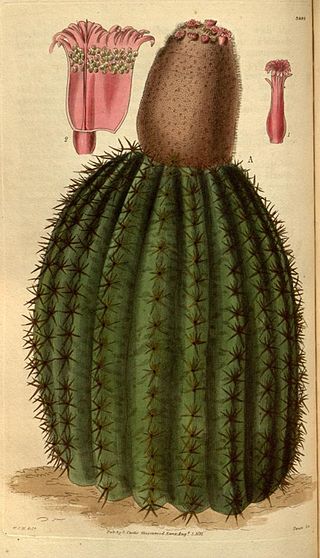
Melocactus intortus, also known as the Turk's cap cactus, is a species of cactus endemic to the Caribbean.
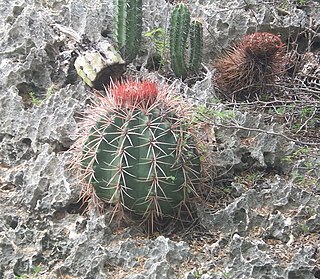
Melocactus caroli-linnaei is a cactus found in Jamaica. When mature it is columnar, up to 1 m (3.3 ft) high. Like all species of Melocactus, it forms a "cephalium" when mature – a dense mass of areoles covered with wool and spines at the tip of the stem. Flowers are produced only from the cephalium.

Melocactus matanzanus, common name dwarf Turk's-cap cactus or Turk's-cap cactus, is a cactus in the genus Melocactus of the family Cactaceae. The epithet matanzanus is derived from the Cuban province of Matanzas.
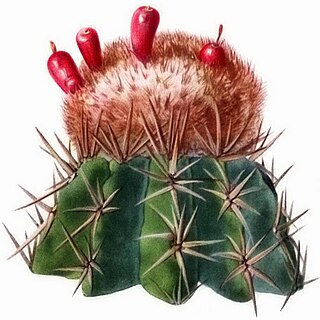
Melocactus lemairei is a species of cactus endemic to the Caribbean island of Hispaniola. It is named after French botanist and cactus expert Charles Antoine Lemaire.

The Cliff Villa Peninsula is a promontory where two currents meet on the north-westerly point of the island of Curaçao

Melocactus neryi is a species of flowering plant from the genus Melocactus.
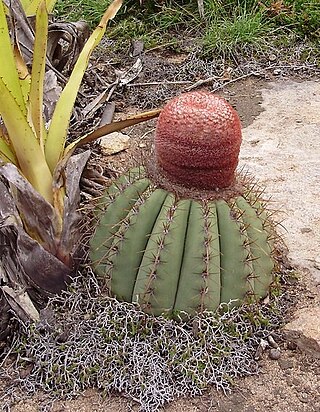
Melocactus ernesti is one of the Turk's cap cacti, and is native to Bahia and Minas Gerais States, Brazil.

Melocactus bahiensis is a species of Melocactus found in Bahia, Brazil.

Melocactus bellavistensis is a species of Melocactus found in Ecuador and Peru.

Melocactus braunii is a species of Melocactus found in Brazil.
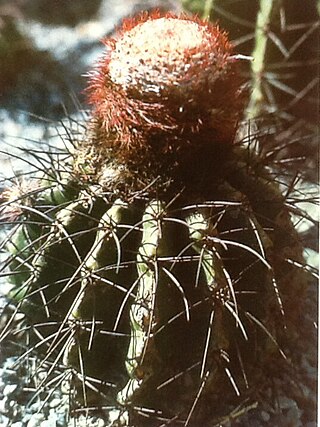
Melocactus estevesii is a species of Melocactus found in Brazil.

Melocactus harlowii is a species of Melocactus found in Cuba.

Melocactus levitestatus is a species of Melocactus found in Brazil.
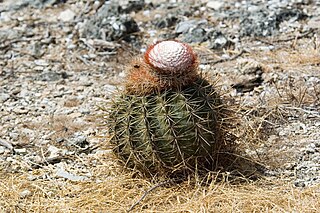
Melocactus macracanthos is a species of Melocactus found in Aruba.




















